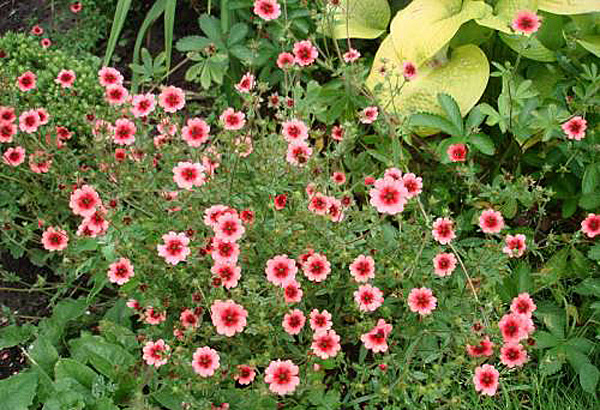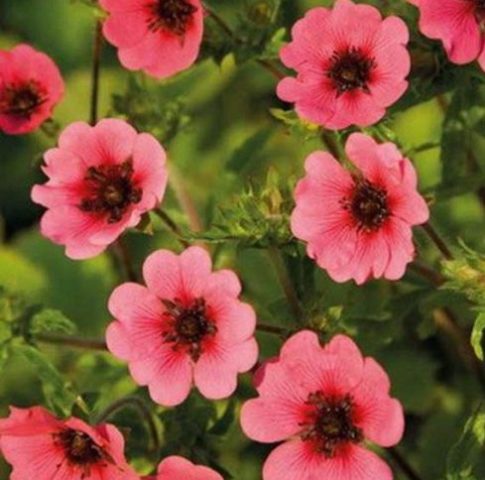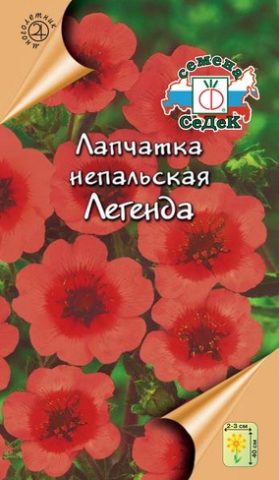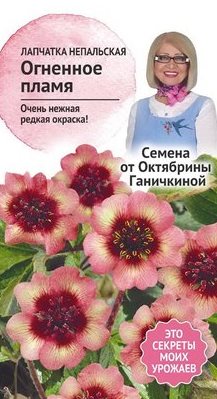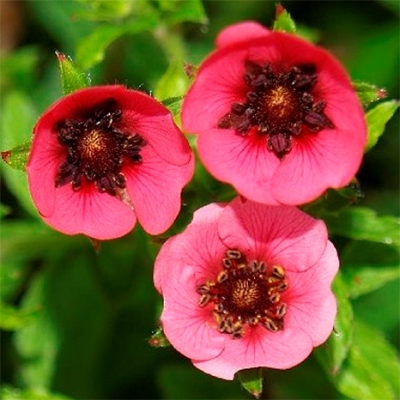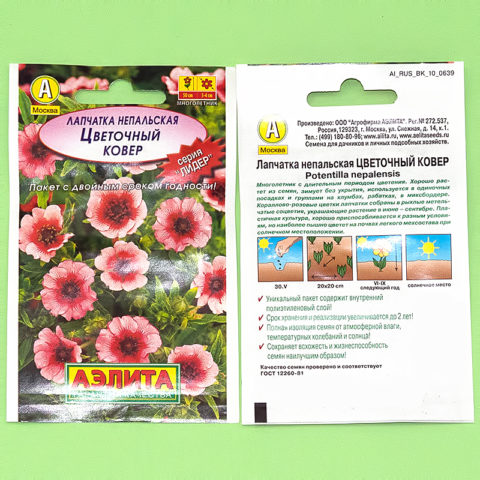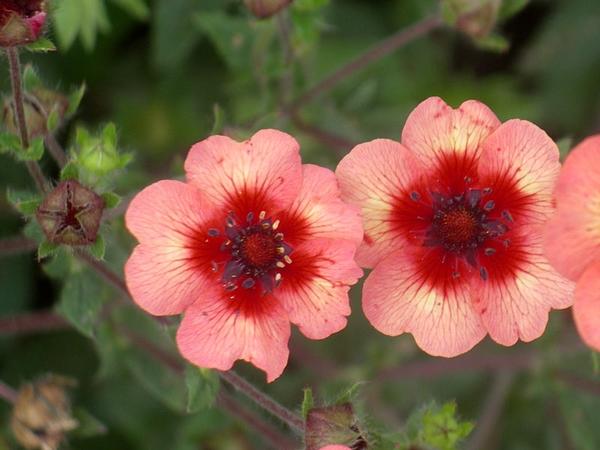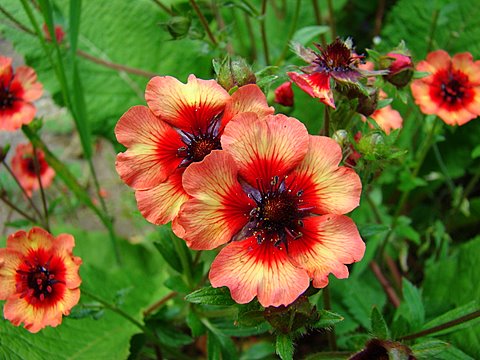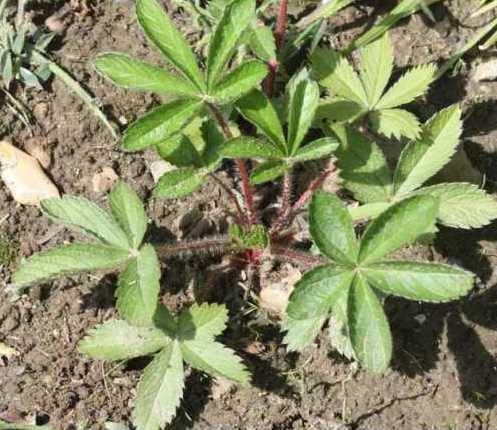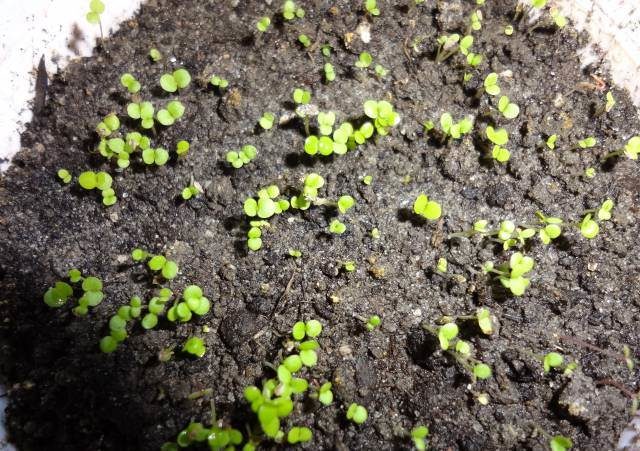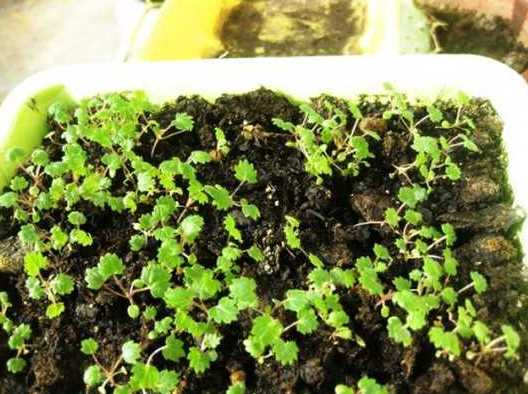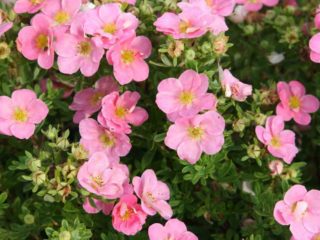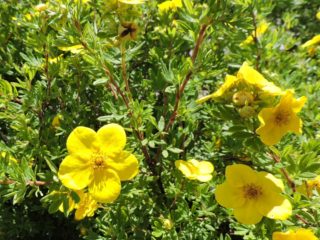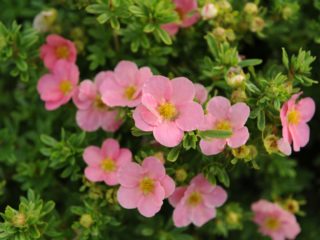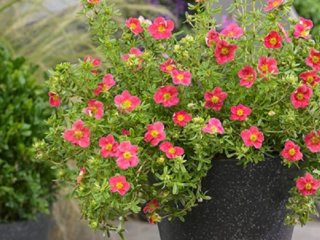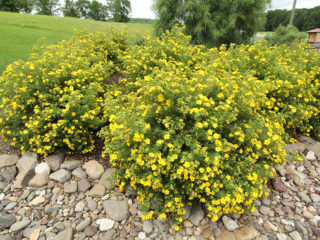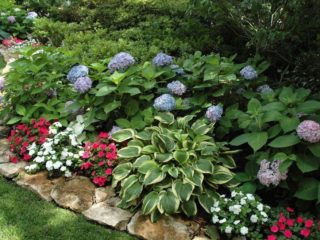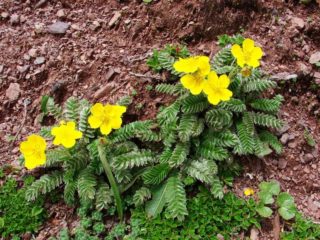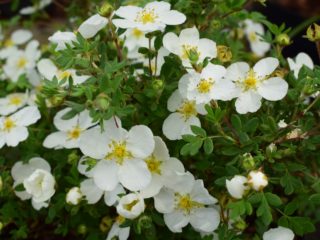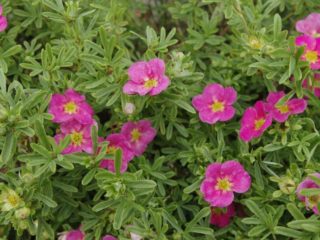Content
- 1 General description of Nepalese cinquefoil
- 2 Popular varieties of Nepalese cinquefoil
- 3 Application in landscape design
- 4 How does Nepalese cinquefoil reproduce?
- 5 Planting and caring for Nepalese cinquefoil
- 6 Planting Nepalese cinquefoil in open ground
- 7 Aftercare (watering, fertilizing, loosening, mulching, pruning, preparing for winter)
- 8 Pests and diseases
- 9 Conclusion
For most gardeners, the ideal is a beautifully flowering perennial plant, which is easily propagated by seeds and does not require special care, while withstanding the rather harsh conditions of the Russian winter. It is safe to say that a plant such as Nepalese cinquefoil comes closest to the requirements of this ideal image.
General description of Nepalese cinquefoil
The Nepalese cinquefoil belongs to the genus Potentilla, which in turn is part of the rose family.The genus Potentilla is one of the most numerous in terms of the number of species included in it, more than 300.
Plants present a wide variety of life forms: from annuals and biennials to perennials, from ground cover creeping grasses to voluminous shrubs, up to 1.5 meters high with woody stems. Some of the wild cinquefoil species have significant medicinal value. It is not for nothing that the Latin name of the genus (Potentilla) is translated as “power”, “strength”.
But not many species are used in culture, and among them, the Nepalese cinquefoil has a special charm. Its homeland is the mountains of the Western Himalayas and Nepal. Hence the comparative unpretentiousness of plants to growing conditions. In the article below you can find not only a description of different hybrid varieties of Nepalese cinquefoil with photos, but also information about planting and caring for this interesting and undemanding plant.
This variety of cinquefoil is a herbaceous perennial, the average height of which varies from 30 to 50 cm. The purple-colored stems grow straight and branch quite strongly. They are covered with interesting finger-shaped leaves that really resemble the paw of some strange animal and can reach a length of 15 cm.
On the other hand, experienced gardeners find some similarities between the leaves of cinquefoil and strawberry, although the former are larger than the latter. It’s not for nothing that both of these plants belong to the same family.
Quite large (up to 3 cm in diameter), five-petalled, most often single flowers bloom at the tops of the shoots from June to August. The petals are heart-shaped or obovate-shaped. They come in all shades of pink or reddish-orange.
Plants have good winter hardiness and, as a rule, do not need shelter for the winter.
Popular varieties of Nepalese cinquefoil
This type of cinquefoil has been used in culture since 1820. Since that time, many interesting and attractive hybrid varieties have appeared, the most popular of which are described below. Just do not confuse Nepalese cinquefoil plants with its shrubby sister, which is also often used in gardening. In any case, Nepalese cinquefoil is a purely herbaceous plant, its shoots never become woody, and its height does not exceed 50 cm.
The varieties of this variety of cinquefoil practically do not differ from each other in care. The main features are the different colors of flower petals and flowering times.
Miss Wilmont
It so happened that the Nepalese cinquefoil variety Miss Wilmott became the most popular, and this is not at all surprising if you look at its photo.
The flowers have such a rich pink hue that it can even be compared to cherry. In the middle of each flower a darker eye is clearly visible, making the color even more expressive.
The variety has more lush and longer flowering than other varieties. At the same time, growing and caring for Miss Wilmott’s cinquefoil is no different. These flowers are winter-hardy and very unpretentious.
Legend
In a variety with such a poetic name, the flowers traditionally have a darker center, almost burgundy in color. At the same time, the petals are characterized by a thick, soft pink hue, which quite abruptly changes first to carmine red and only then turns into a completely dark eye.
Growing Nepalese legend cinquefoil is not particularly difficult, and the photo shows one of the most common manufacturing companies from which you can buy seeds of these flowers.
fire flame
Nepalese fireweed flowers have a unique color. The dark center, combining crimson and red shades, occupies most of the flower. And against the background of gently vanilla petals with pink tints, it seems that it is burning with a bright flame.
Flowering of this variety begins in July and lasts until September. Although the plants themselves are not large in size, growing up to 40 cm in height, they look very impressive.
Ron McBies (RON MC BEATH)
The flower color of this variety is slightly reminiscent of Miss Wilmott's cinquefoil. The rich pink, almost cherry tint of the petals fades into a darker, star-shaped center.
But, as follows from the description of the variety, in terms of height, Nepalese cinquefoil Ron Mac Bis is distinguished by the smallest size, reaching only 30 cm. But the flowering is very abundant and long-lasting, it can last from May to September.
Floral carpet
The flowers of this variety have a coral tint with a traditional darker center. The name of the variety itself characterizes the long flowering period in terms of time and the number of flowers formed - from mid-June to mid-September.
Adapts well to almost any soil, but requires a sunny location for such abundant flowering.
Floris
Another popular variety of Nepalese cinquefoil, blooming during June-July. The petals have a light coral tint that turns into an orange-red center.
The bushes of this variety are medium in size, growing up to 50 cm.
Roxana
The flowers of this variety look no less attractive than other varieties of cinquefoil. The salmon-orange shade of the petals is distinguished by lighter, creamier tints. From the dark center there are many veins that beautifully speckle the light petals.
Application in landscape design
In the landscape design of an area, Nepalese cinquefoil looks very expressive when planted alone, thanks to the original coloring of the flowers, especially if you create a carpet of several of its varieties of different colors, for example, Miss Wilmott, Roxana and Legend. She will be welcome on large alpine hills, in gardens among stones.
Borders made from cinquefoil plants planted in a row, which can be used to enclose flower beds or paths, will also look great.
But these plants combine very harmoniously with other perennials, creating bright spots in mixborders. They will stand out against the background of relatively low-growing flowers, such as speedwells and bells. And they will create a bright carpet that goes well with medium-sized flowers, such as cornflowers, lupins, and cornflowers.
How does Nepalese cinquefoil reproduce?
Nepalese cinquefoil can be propagated quite easily by almost any of the known methods.
Seminal
Potentilla seeds can be sown at almost any time.If we are talking about sowing indoors, then throughout the year, if it is possible to provide a sufficient amount of light to young plants. Plants bloom only the next year after sowing, but the plants are guaranteed to be strong, healthy and can be used to make a whole flower meadow at once.
Judging by reviews from gardeners, propagating Nepalese cinquefoil from seeds is not at all difficult. The seeds germinate well even when sown in open ground and powerful flowering plants quickly develop from them.
Dividing the bush
This propagation method can be applied to cinquefoil bushes that have lived in one place for at least 4 years. The bushes are dug up in warm weather in spring or autumn and divided into several parts with a sharp knife. So that each part contains a certain number of roots and buds (leaves).
They are planted immediately after separation in a new place, maintaining an interval of 25-40 cm between plantings.
By layering
Reproduction by layering is carried out in mid-summer, in July or August. To do this, choose a strong and healthy shoot that grows in close proximity to the surface of the earth. It is lightly cut with a sharp knife. Then they tilt it to the ground and fix it in such a position that the incision is covered with soil. Usually by autumn the shoot has time to grow roots at the site of the cut. Then it is separated and immediately planted in light and loose soil.
Cuttings
Cuttings for rooting can be collected from last year's ripened shoots of cinquefoil throughout the summer. They are usually cut 9-10 cm long. The lower leaves are removed, leaving only a few in the upper part of the shoot.The lowest part of the cutting is treated with phytohormones and planted in light, loose soil. You can plant them in small containers for rooting, and if there are a lot of cuttings, they are immediately placed in the soil in a shady area of the site. It is advisable to cover them on top with polyethylene on arcs or plastic bottles to create a greenhouse effect of high humidity. The soil underneath must be kept constantly moist. And if buds form on the cuttings during the rooting process, then they need to be removed. In autumn, stronger plants with roots can be planted in a permanent place.
Planting and caring for Nepalese cinquefoil
Nepalese cinquefoil is a very easy-to-care and undemanding plant. However, for it to become a worthy decoration of the site, it is necessary to understand and fulfill all its basic preferences.
How to sow Nepalese cinquefoil for seedlings (timing, rules)
Nepalese cinquefoil seeds collected or purchased in a store retain good germination rates for 2-2.5 years.
Cinquefoil can be grown using seedlings literally all year round. The most convenient time frame is from February to April, since as a result, the grown plants can be transplanted into open ground at a selected permanent growth site already this season (in August-September).
Since cinquefoil seeds are small in size, they are sown superficially on moist soil and lightly sprinkled with fine sand on top.In room conditions at a temperature of + 20-22 ° C, it is advisable to cover the sown seeds with glass or polyethylene to maintain the necessary humidity. After about 12-15 days, the first shoots should appear.
During this period, caring for young cinquefoil sprouts comes down to placing them in a cool, bright place with a temperature of about + 18 ° C and moderate watering 2-3 times a week.
Nepalese cinquefoil pick
During the first 3-6 weeks, seedlings develop very slowly. They seem to be frozen in place and not growing at all. After 4-5 weeks of development, when the first true leaves appear, young cinquefoil sprouts can be picked into separate containers. If you do this carefully, trying to affect the microscopic roots to a minimum, then the plants will not only not stop growing, but will begin to develop at a faster rate.
When picking, it is important to take into account the acidic and mechanical composition of the soil. Due to its unpretentiousness, cinquefoil will grow on almost any soil, but will not show the abundant and long flowering that it is capable of in favorable conditions. Plants prefer light and loose soils with a neutral or even slightly alkaline reaction.
When warm weather sets in, seedlings at the age of 2-2.5 months can already be planted in a permanent place in open ground.
Seedling care
Potentilla seedlings will not require any special care. Plants only need to be watered regularly, being careful not to overdo it with the amount of moisture. After two months, young plants can be fed with highly diluted complex fertilizer.
Planting Nepalese cinquefoil in open ground
Potentilla plants can be planted in open ground at any warm time of the year, from May to September inclusive.Moreover, replanting bushes, if necessary, is also possible, both in spring and in autumn after flowering.
Despite the fact that plants can exist in partial shade, this choice will not be the best for their full development. Nepalese cinquefoil can show itself in all its glory only in an area well lit by the sun. After all, if you look closely at a flowering plant, it will become clearly visible that in cloudy and non-sunny weather the flowers do not even fully open.
In terms of soil preparation, it is necessary to monitor drainage. Water should not stagnate at the future planting site.
Planting cinquefoil plants itself will not cause any difficulties even for novice gardeners. Plants are planted in holes specially dug and spilled with water, keeping a distance of 20-30 cm between them.
Aftercare (watering, fertilizing, loosening, mulching, pruning, preparing for winter)
If the weather is dry and hot, the cinquefoil needs watering 2-3 times a week. For 1 sq. per meter of planting consumes about 10 liters of water.
In rainy and cloudy weather, watering plants should be limited, since the root system of flowers may suffer from excessive moisture.
Three times during the entire growing season, cinquefoil can be fed with organic fertilizers. It is very good to add ash solution to them. It is better to time fertilizing to coincide with the following phases of plant development:
- in early spring, immediately after the main snow cover melts;
- approximately in mid-May, at the time of the formation of the first buds on the plant;
- after flowering - in August or September.
Instead of loosening the soil and removing weeds under the cinquefoil, it is more advisable to use mulching with any organic matter: hay, straw, rotted sawdust. This can be done both in the spring and throughout the growing season.
Only wilted, dried out and diseased shoots of plants are pruned. Regular removal of faded flowers promotes longer flowering.
The Nepalese cinquefoil flower tolerates almost any frost well. Bushes should be protected only in regions where in winter there are simultaneously frosts above -25 °C and thaws to zero or above. In this case, a good layer of mulch or pine spruce branches can help.
Pests and diseases
In general, plants are rarely attacked by parasites and pathogens.
But with excess moisture, Nepalese cinquefoil plants can be affected by fungal diseases: rust, powdery mildew or brown spot. For treatment, use Bordeaux mixture or any systemic fungicide.
Of the pests, the most active are usually cutworms, which are easy to combat by spraying with any insecticide: Fitoverm, Fufanon and others.
Conclusion
Nepalese cinquefoil is a very unpretentious perennial flowering plant that will be a welcome guest in almost any area. It gets along well with any flowers, and may well act as a soloist, decorating a flowerbed or border.
